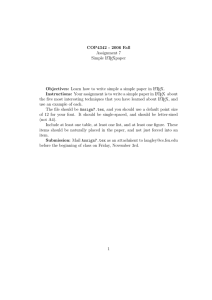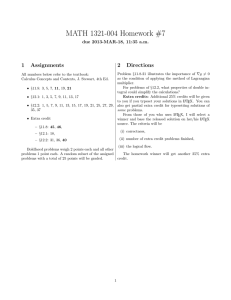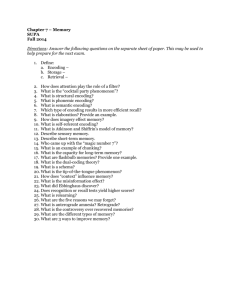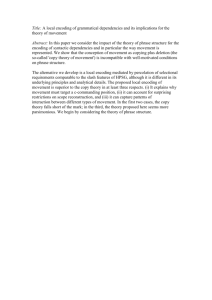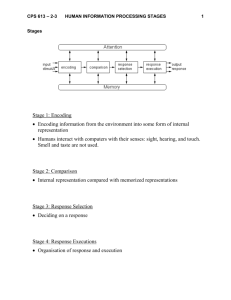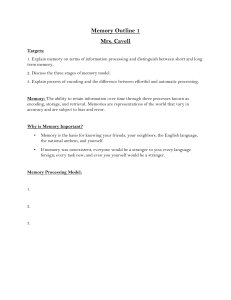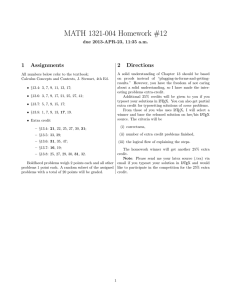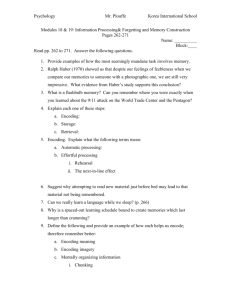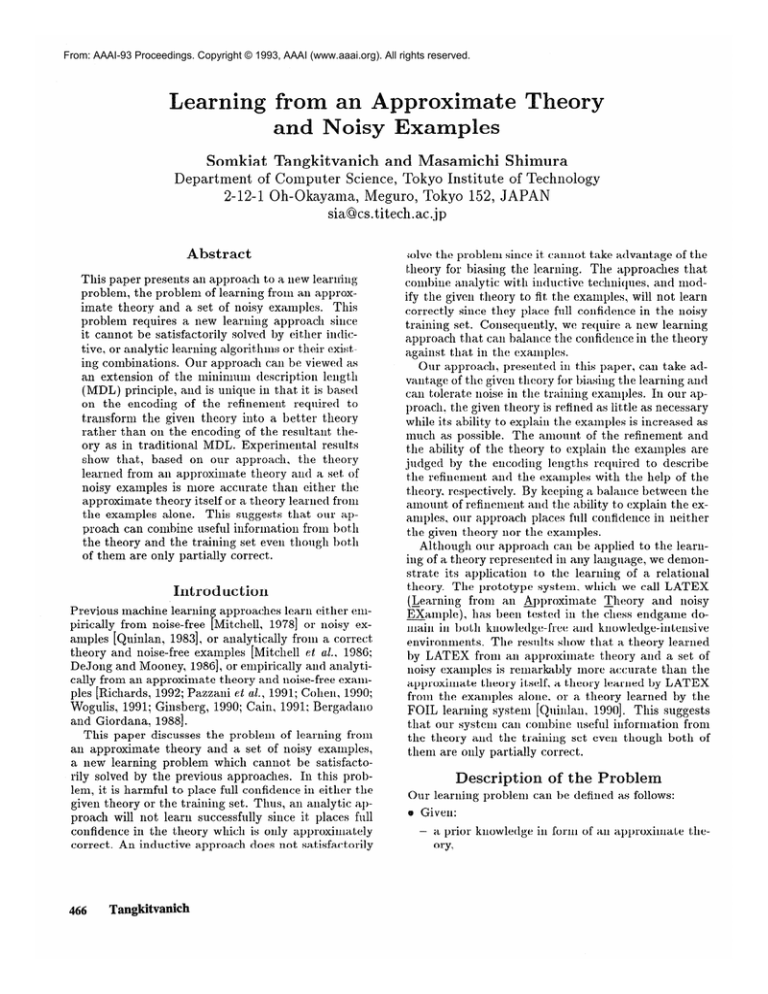
From: AAAI-93 Proceedings. Copyright © 1993, AAAI (www.aaai.org). All rights reserved.
Learning
from an A
Noisy E
Somkiat Tangkitvanich and Masamichi Shimura
Department of Computer Science, Tokyo Institute of Technology
2-12-1 Oh-Okayama,
Meguro, Tokyo 152, JAPAN
sia@cs.titech.ac.jp
Abstract
This paper presents an approach to a new learll’ing
problem, the problem of learning from an approximate theory and a set of noisy examples.
This
problem requires a new learning approach since
it cannot be satisfactorily
solved by either indictive, or analytic learning algorithms or their existing combinations.
Our approach can be viewed as
an extension of the minimum description
length
(MDL) principle, and is unique in that it is based
on the encoding of the refinement
required to
transform
the given theory into a better theory
rather than on the encoding of the resultant theory as in traditional
MDL. Experimental
results
show that, based on our approach,
the theory
learned from an approximate
theory and a set, of
noisy examples is more accurate than either the
approximate theory itself or a theory learned from
This suggests that our apthe examples alone.
proach can combine useful information from both
the theory and the training set even though both
of them are only partially correct.
Introduction
approaches learn either emPrevious machine learnin
19781 or noisy expirically from noise-free YMitchell,
amples [Quinlan, 19831, or analytically
from a correct
theory and noise-free examples [Mitchell et al., 1986;
DeJong and Mooney, 19861, or empirically and analytically from an approximate theory and noise-free examples [Richards, 1992; Pazzani et ul., 1991; Cohen, 1990;
Wogulis, 1991; Ginsberg, 1990; Cain, 1991; Bergadano
and Giordana, 19881.
This paper discusses the problem of learning from
an approximate
theory and a set, of noisy examples,
a new learning problem which cannot be satisfactorily solved by the previous approaches.
In this problem, it is harmful to place full confidence in either the
given theory or the training set. Thus, an analytic appreach will not learn successfully
since it places full
confidence in the theory which is only approximately
correct. An inductive approach does not satisfactorily
466
Tangkitvanich
;olvc the problem since it, cannot take advantage of the
theory for biasing the learning.
The approaches that
combine analytic with inductive techniques, and modify the given theory to fit, the examples, will not learn
correct,ly since they place full confidence in the noisy
we require a new learning
training set. Consequently,
approach that can balance the confidence in the theory
against that in the examples.
Our approach, presented in this paper, can take advantage of the given tlioory for biasing the learning and
can tolerate noise in the training examples. In our approach. the given theory is refined as little as necessary
while it,s ability to explain the examples is increased as
much as possible. The amount of the refinement and
the ability of the theory to explain the examples are
judged by the encoding lengths required to describe
the refinement, and the examples with the help of the
theory. respectively.
By keeping a balance between the
amount of refinement and the ability to explain the examples, our approach places full confidence in neither
the given theory nor the examples.
Although our approach can be applied to the learning of a theory represented in any language, we demonstrate its applicattion t,o the learning of a relational
theory. The prototype system, which we call LATEX
(Learning
from an &)proximate
zhcory
and noisy
Example),
has been tested in the chess endgame domain in both knowledge-free
and knowledge-intensive
environments.
The results show that a theory learned
by LATEX
from an approximate
theory and a set of
noisy examples is remarkably more accurate than the
approximate theory itself, a theory learned by LATEX
from the examples alone, or a theory learned by the
FOIL learning system [Quinlan. 19901. This suggests
that our system can combine useful information
from
the theory and the training set even though both of
them are only partially correct.
escription
Our learning
problem
o Given:
- a prior knowledge
ory,
of the Problem
can be defined as follows:
in form of an approximate
the-
- a set, of noisy positive and negative
exa~iiples.
e Find:
-
a theory phich is similar to the given t,heory but
is expected to he more accurate in classifying the
unseen examples.
The fundamental assumption of learning from an iuitial theory is that although the theory is flawed, it is
still relatively ‘bclose” or “a~)~~roxilllates’” to the target theory [Mooney, To appear].
Intuitively,
au approximate theory is supposed to facilitate the leariiiug
rather than hinder it. Such a theory can be obtaiiied
from a human expert, a prior learning [Muggleton et
(II., 19921, a textbook
[Cohen, 19901 or other sources.
It has been pointed out that, the accuracy of a theory
is not a good criterion to quantify its approxi~~~ateness [Mooney, To appear: Pazzani and Kibler, 19921.
Unfortunately,
there has been no satisfactory
criterion
yet. In the next section, we show that t,he notion of an
approximate
theory can be precisely defined based 011
the encoding length of the refinement.
ur
Approach
We present a new learning approach based 011 ~iicoding a refinement and examples.
The approach can be
viewed as an extension of the nlininlum description
length (MDL) principle [Wallace and Boulton.
1968;
Rissanen,
19781. a general principle applicable to any
inductive learning task involving sufficient, exalnples.
According to the principle, the simplest theory that,
can explain the examples well is the best one. Simplicity of a theory is judged by its length under an encoding scheme chosen subjectively
by the cxl>erilllollt,c~r.
The ability of a theory to explain the given ex~tmples
is judged by the length of the examples oncod~td with
the help of the theory, with shorter length indicating
From the MDL perspective,
more ability to explain.
learning occurs only when the sum of these encoding
lengths is less than the explicit encoding length of the
examples, that is when there is a compression.
General as it is, the MDL principle in its original
form cannot take advantage of a prior knowledge in the
form of an initial theory. This is a weakness since the
information
in the theory may be esseiit,ial for i~ii ax:curate learning when sufficient exanlples are ilot, available. Our approach extends the MDL principle so that,
it can take advantage of au initial theory.
Extending
MDL to Learn
Approximate
Theory
from an
the theory that, is most similar to
In our approach,
the given theory and can explain the ex;~nlplcs well
is the best theory.
Similarity
betweeu a theory T’
alld the giveu theory T is judged by the length under some encoding scheme to describe the r~:finxmcrt.t
required to trausforln T into T’. The ability of a t.h(:ory to explain the examples is judged by the l~~ugth
of the examples eiicotled wit,11 the h(alp of the theory,
with shorter leiigth indicat~iug more ability to explain.
Qualitatively,
the best, theory is the theory with the
niiniinuiii description length calculated from the sum
of
1) the description
length
of the refinement,
2) the description length of the examples
with the help of the refined t,heory.
and
encoded
The refilled theory ill 2) c:~n be obtained from the
initial theory and the description
of the refinement.
Wlicu the bias for a siuiilar ttilieory is appropriate,
as
iii the case of learuing from an approximate
theory, a
learning algorit,hm based 011 our approach will achieve
a higher accuracy than an algorithm that cannot learn
from a theory. It, should be noted that when there is
no initial theory, the bias reduces to one that prefers
the simplest theory t,hat, cau explain the examples, and
our approach degenerates to the MDL approach.
The enq~hasis 011 encoding refinemcmt is a unique
feature of our approach.
It, has t,lie following advantages for our learning problem.
It, can balance the coiifidmcc in the theory agaiiist
that8 in the training set. Coiisequeutly, our approach
can take advantage of the information
in both the
t,heory and the training set, while being able to avoid
the pitfalls of placing full confideiice in either of
them.
From a Bayesian perspective,
our approach
can be interpreted
as assigning a prior probability
to each theory iii the liypot8hesis space, favoring the
ones which are similar t#ot,lic givcii theory, updating
the probability by using the traiiiiiig examples. and
solectiug the t,hoory t,liazt llt~ts it inaxiiiiuni posterior
probability.
However, in comparison wit,11a Bayesian
approach, an approach based on the MDL principle provides the user wit,11 the coiiceptually
simpler
problem of coinputing code lengths, rather than estimating probabilities
[Quinlan and Rivest, 19891.
It, provides a precise way to define au approximate
theory. Intuitively, ail approxiinato
theory is a theory that, fa.cilita.tes the learning ratther thau hinder it.
Since learning is relat,cd to producing a compression
in the encoding leiigt81i. an approxiniate
theory can
be judged based 011 thcl help it, provides in shortening
the description length of the target, theory.
Given
au al~l~roximate thmry. t,hcb encoding of the target,
theory as a sequeiic~~ of refineiuents of that theory
should be shorter than a direct encoding of the target, t,heory. This leads t,o the following definition.
Definition 1 Approximate Theory
A thxxwy To is ~~71.
approzirr~~atr theory of T, uln&r
an encoding scheme E ifllE(T”, T,) < lE(q5, T,), ~ud~~ere
ZE(Ti, Tj ) is the 1~71,gthr~(/,~~ir~d
to f”G’*COdCthse trUT)sSfOTzmsu,tion.
from Ti in,to Tj . CXTM~
4 i.~ ~~71.
~~~,~t~th.cory.
How ca11 such a theory facilitate learning?
Within
t,hc: PAC learnability
framework [Valiant,, 19841, the
followiiig tlieorcm shows that it. reduces the sample
NovcellM&hods
in
owledge Acquisition
467
complexity of any algorithm that accepts an initial t,heory Z’s and i) never examines a hypothesis
hl before
another hypothesis
h2 if ZE(TO, h2) < ZE(TO, hl), and
ii) outputs ‘a hypothesis consistent
with the training
examples.
Such an algorithm reflects important, elements of a number of existing algorithms (e.g., [Ginsberg, 1990; Cain, 19911) that modify the initial theory
to fit the examples.
Theorem 1 Let L be any algorithm
th*at satisfies i)
and ii). For a finite hypothesis space, L with. an approximate theory To has less sam,ple complexity th.an L
with an empty theory 4.
The above theorem is applicable when the examples
are noise-free. The proof of the theorem and an analogous theorem for learning from noisy examples is given
in [Tangkitvanich
and Shimura, 19931.
Learning
a Relational
In learning a relational
theory are represented
function-free
first-order
Encoding
Training
Theory
theory, the examples and the
in form of tuples and a set of
Horn clauses, respectively.
Examples
From the MDL perspective, learning occurs when there
is a compression
in the encoding length of the examples.
In learning a relational
theory,
although
both the positive and negative examples are given,
it is a common practice to learn a theory that characterizes only the positive examples [Quinlan,
1990;
Muggleton and Feng, 19901. In encoding terms, this
suggests that it is appropriate
to compress only the
encoding length of the positive examples.’
One way to
produce a compression is to encode the examples with
the help of an approximate
theory.
From Shannon’s
information
theory,
the optimal
code length for an object e that has a probability p,
is - log,p, bits. Without the help of an initial theory,
the optimal code length required to indicate that an
example is positive is thus -log, po bits, where pe is
the probability that an example left in the training set
is a positive example.
In contrast,
with the help of
CZ, a clause in an approximate
theory that covers the
example, the optimal code length becomes - log2 pcl
bits, where p,l is the probability that an example covered by CZ is a positive example. Consequently,
there
is a compression produced by CZ in encoding a positive
example if p,l > po, that is when the positive examples
are more concentrated
in the clause than in the training set. The total compression obtained in encoding n
positive examples covered by CZ is
Compress(Cl)
= n x (log,
PO -
log,
m
1.
(1)
‘On the contrary, if a theory that characterizes both
types of examples (e.g., a relational decision tree [Watanabe
and Rendell, 19911) is to be learned, it would be appropriate
to compress the encoding length of both types.
468
Tangkitvanich
The compression
produced by a theory is the sum
of the compressions
produced by all the clauses in the
theory. By using a more accurate theory to encode the
examples, we can obtain further compressions.
Such a
theory can be obtained by means of refinement.
However, the compression is not obtained without any cost
since we have to encode the refinement as well.
Encoding
Refinements
We assume that the head of each clause in the theory is
identical. This limits the ability to learn an intermediate concept but simplifies the encoding of a refinement.
With this assumption.
it is possible to encode auy refinement by using only two basic transformations:
a
literal addition and a literal deletion.
Other forms of
t,ransformation
can be encoded by using these. For example, literal replacement
can be encoded by using a
combination
of a literal addition and a literal deletion.
Clause addition can be encoded by using a combination of literal additions. The head of a new clause need
not be encoded since it is identical to that of an existing clause. Clause deletion can be encoded in a similar
way by using a combination
of literal deletions. Thus,
the overall refinement can be encoded by the following
self-delimiting
code:
In1 1refinel,lI
In2 1 refine2,1
refineI,
I... Irefinel,,,
1
I re f ine2.2 I... (refine.2,,
I
..
InkI refinek.11
..
.
..
.
refineb*2I...jrefinek,,,I
In the above encoding scheme, ni is the encoding
of an integer indicating the number of refinements applied to clause i (with n; = 0 indicating
no refinement), refinei,j
is the encoding of the j-th refinement
to clause i. refine;,j
is composed of a one-bit flag
indicating whether the refinement is a literal addition
or a literal deletion, and the encoding of the content
of the refinement.
For a literal addition, the encoding of the content contains the information required to
indicate whether the literal to be added is negated or
not, and from which relation and variables the literal
is constructed.
For a literal deletion, the encoding of
the content contains the information
required to indicate which literal in the clause is to be deleted. Note
that the encoding scheme is natural for our learning
problem in that it requires a shorter encoding length
for a refinement that has a littler effect on the theory.
For example, adding a literal requires a shorter length
than adding a clause.
We now quantify the relationship
between the refinement and its effect on the compression in the encoding length. Let CZi be a clause in the initial theory,
Length(refinei,j)
be the length required for re fine;,j,
and Cl: be the refined clause obtained from CZ; and
refine+.
The compression produced by the refinement, can he estimated by
Compression(re
f ine;,j)
Compress(CZi)
The
Learning
= Compress(
- Length(refinei,j).
Cl:)(2)
Algorithm
The algorithm of LATEX
is very simple. In each iteration, the theory is refined by using all the possible
applications
of the following refinement operators:
a
clause-addition
operator, a clause-deletion
operator, a
literal-addition
operator and a literal-deletion
operator. The literal-addition
operator adds to an existing
clause a literal in the background knowledge. The literal must contain at least one existing variable and
must satisfy constraints
to avoid problematic
recursion. The clause-addition
operator adds t,o the theory a new clause containing
one literal.
Among all
the possible refinements, LATEX selects one that produces maximal positive compression.
The system terminates when no refinement
can produce a positive
The refined theory is then passed to a
compressions.
simple post-processing
routine which removes clauses
that cover more negative than positive examples.
Admittedly,
the current greedy search strategy and
the simple refinement operators prevent LATEX from
learning some theories, e.g., those contain literals that
do not discriminate
positive from negative examples.
We are now incorporating
a more complex search strategy and better operators to overcome this limitation.
Experimental Evaluations
LATEX
has been experimented
on the king-rookking board classification domain described in [Quinlan,
1990; Richards,
19921. In this domain, there are two
types of variable, representing
row and column.
For
each type, there are three relations given as the background knowledge:
eq(X, Y) indicating
that X is the
same as Y, a&(X, Y) indicating that X is adjacent to
Y and Zessthan(X, Y) indicating that X is less than Y.
In our experiments,
the training sets are randomly
generated
and noise are randomly
introduced
into
them. To introduce noise, we adopt the classification
noise model used in [Angluin and Laird, 19881. 111 this
model, a noise rate of 7 implies that the class of each
example is replaced by the opposite class with probability 7. The test set is composed of 10,000 examples
selected independently
to the training set.
The experiments
are made on 5 initial
theories which are the operationalized
version of those
used by FORTE
[Richards,
19921.
The
theories are generated
by corrupting
the correct theory
with six operators:
clause-addition,
clause-deletion,
literal-addition,
literal-deletion,
literal-replacement
and variable-replacement
operators.
Each corrupted
theory is an approximate
theory according to our definition and is averagely 45.79% correct.
The average
number of clauses in an operationalized
theory is 14.2,
and the average number of literals in a clause is 2.8,
Figure 1 compares the learning curves of LATEX
with an initial theory (LATEX-Th),
LATEX
without
an initial theory (LATEX-NoTh),
and FOIL [Quinlan,
19901, for q = 10%. The curves demonstrate
many
interesting points. First, throughout
the learning session, the theory learned by LATEX
from an initial
theory and the examples is significantly more accurate
than that, learned by LATEX from the examples alone.
Further, although the training examples are considerably noisy, the theory learned from the initial theory
and
the examples is much more accurate than the initial theory itself. This means that LATEX can extract
useful information from the noisy examples to improve
the accuracy of the theory.
In other words, the experiments
show that by combining the information in the theory and the examples,
LATEX achieves a higher accuracy than it could with
either one alone.
Both are beneficial to the system.
This suggests a dual view of our approach: as a means
of refining an initial theory using examples, or as a
means of improving the learning from examples using
an initial theory.
It is also interesting to compare the learning curve of
LATEX with that of FOIL. Without an initial theory,
LATEX
degenerates
to an ordinary inductive learning system based on the MDL principle.
Throughout the training sessions, the theory learned by LATEX is significantly
more accurate than that learned
by FOIL. However, another experiment
which is not
reported here shows that there are no significant differences in the accuracies achieved by the two systems
when there is no noise in the training set. Hence, the
differences can be attributed
to the differences in the
noise-handling
mechanisms of the two systems. Investigation reveals that, when the examples are noisy, the
theories learned by FOIL contain more literals and require longer encoding lengths than those learned by
LATEX.
In other words, t,he theories learned by FOIL
are much more complex.
elated Work
In this section, we discuss three related approaches
for learning
a relational
theory from noisy examples.
Other approaches
(e.g., [Towell et al., 1990;
Drastal et cd., 1989; Ginsberg, 19901) will be discussed
in the full paper.
e FOIL
Unlike LATEX. FOIL [Q inn
’ 1an, 19901 is a relational
learning system that cannot take advantage of an
initial theory.
However, it is informative
to compare the two systems from an inductive learning perspective.
FOIL uses an information-based
heuristic called Gain to select a literal and uses another
information-based
heuristic as its stopping criterion
to handle noise. In contrast, LATEX
uses a single
compression-based
criterion for both tasks.
When
used to select a literal, our criterion and Gain are
Novel Methods in Knowledge Acquisition
469
Accuracy
100
95
90
85
80
75
70
65
60
55
10
20
Figure
30
Number
1: Learning
8 FOCL
FOCL extends FOIL to learn from an initial theory
in an interesting
way. However, the ori inal algorithm of FOCL [Pazzani and Kihler, 1992 7 is unsuitable for learning from noisy examples since it refines
the given theory to he consistent with them. Two
extensions of FOCL are designed to deal with noise:
one with FOIL’s stopping criterion, the other with a
pruning technique [Brunk and Pazzani, 19911.
Currently, we are not aware of any experimental
results of testing any FOCL algorithms
in learning
from an initial theory and noisy examples.
However, it should be noted that while FOCL with the
pruning technique requires another training set, for
pruning, and both extensions of FOCL use separate
mechanisms for selecting liter& and handling noise,
LATEX requires a single training set and uses a single mechanism for both tasks.
et. al’s
Learning
System
Recently, Muggleton et. al. [Muggleton cf o,Z., 19921
proposed an approach to learn a theory represented
as a logic program from noisy examples.
The system based on their approach receives as an input an
470
Tangkitvanich
Examples
curves of LATEX
similar in that they suggest selecting a literal that
discriminates positive from negat,ive examples. However, when used to handle noise, our criterion and
FOIL’s stopping criterion have different effects. The
experiments reveal that a theory learned by FOIL is
much more complex than that learned by LATEX.
This is because FOIL’s stopping criterion allows the
building of long clauses to cover a small number of
examples. Former study [Dzeroski and Lavrac. 19911
also arrived at the same conclusion.
e Muggleton
40
of Training
50
60
and FOIL
overly general theory learned by the GOLEM system
[Muggleton and Feng, 19901. It then specializes the
theory by using a technique called closed-world specialization [Bain and Muggleton,
19901. If there are
several possible specializations,
the one that yields
maximal compression is selected.
Since the system
attempts to minimize the encoding length. it can be
viewed as incorporating
the MDL principle.
From the point, of view of learning from an initial
theory. there is an important difference between the
theory acceptable by their system and that acceptable by LATEX.
While their system assumes an
overly general theory produced by a prior learning
of GOLEM,
LATEX
requires no such assumptions.
LATEX
can accept a theory that is overly general,
overly specific, or both. The theory can be obtained
from an expert, a textbook,
a prior learning and
other sources.
Conclusion
We presented an approach for learning from an approximate theory and noisy examples. The approach is
based on minimizing the encoding lengths of t,he refinement and the examples, and can be viewed as an extension of the MDL principle that, can take advantage of
an initial theory. We also demonstrated
the applicability of our approach in learning a relational theory, and
showed that the system based on our approach can tolerate noise in both the knowledge-free and knowledgeintensive environment.
In the knowledge-free environment, our system compares favorably with FOIL, In
the knowlodge-illt,ol~sive environment.
it combines useful information
from both the theory and the training
set and achieves a higher &curacy than ii could wit,11
our approach (*ail be
either one alone. Consequently,
viewed either as a means to improve the accuracy of an
initial theory using training examples. or as a means
to improve the learning from examples using an iiiit,ial
theory.
Directions
for future work include ex~~Criillc~llt~i~lg
with other models of noise in the examples and corn-paring an approximate theory according to our formalization with a theory obtained from a knowledge source
in a real-world domain.
Acknowledgments
We would like to thank Hussein Almuallim for his insightful comments.
We are also indebted to Boonserm
Kijsirikul for his excellent help in implementing
LATEX, Tsuyoshi Murata and Craig Hicks for their help
in preparing the paper.
eferences
Angluin, D. and Laird, P. 1988. Learning
examples. Machsine Learning 2:343 -370.
Bain, M. and Muggleton,
S. 1990.
learning.
In Muchsine InteZZigeneelZ
sity Press.
from noisy
Non-irlonotoilic
Oxford Univer-
Bergadano,
F. and Giordaila, A. 1988. A knowledge
intensive approach to concept induction. In Prop. ;the
Fifth International
Conference on Machsine Learning.
Morgan Kaufmann.
305-317.
Brunk, C. and Pazzani, M. 1991. An investigation
of
noise-tolerant
relational concept learning algorithms.
In Proc. the Eighth, Intem.ntionm! Workshop on Muchiane Learning. Morgan Kaufman.
389 393.
Cain, T. 1991. The DUCTOR:
A theory revision system for propositional
domains.
In Proc. the Eighth.
International
Worksh.op on Machine Learning. Morgan Kaufman.
485-489.
Cohen, W. 1990. Learning from textbook knowledge:
In Proc. the Eighth, National ConA case study.
ference on Artificial Intelligence.
AAAI Press/MIT
Press. 743-748.
Mitchctll, T.M.: Keller. R .M.: and Kedar-Cabelli,
1986. ExI’l;Lnattioll-bas~~(l learning:
A unifying
80.
Machine Lemw,ing 1( 1):47
S.T.
view.
Mitcllcll, T. M. 1978. Version spaces: An approach to
concept, learning. Tc(.hnical R.eport, HPP-79-2,
Stanford University, Palo Alto. CA.
Mooney, R. To appear. A preliminary PAC analysis
of theory revision. In Pet,sche. T.; Judd, S.; and Hanson, S., editors. Cornp~~tntional Lewrr~.in.gTheory and
Natuml Lmr+n.ing Systmm volume 3. MIT Press.
Mllggleton, S. and Feng, C. 1990. Efficient induction
In Proc. th.e First Corlfwence on
of logic programs.
Algorithmic Learning Tiwory. OHMSHA.
368 -381.
Muggleton.
S.; Srinivasan,
A.: and Bain, M. 1992.
Compression,
significance and accuracy. In Proc. the
Ninth Ir~,ter76crtiorl,clCortjerencc on. Machine Leuming. Morgan Kaufmann.
339-347.
Pazzani, M. and Kibler, D. 1992. The utility of knowledge in inductive learning. M&&,e
Learning 9:57--94.
Pazxani, M.; Brunk, C.; and Silverstein, G. 1991. A
approach to learning relational
krlowlcdge-int,ellsive
concepts. In Proc. the Eighth, Inkrn~ationml Workshop
on. Machine Learning. Morgan Kaufman.
432- 43G.
Quinlan, J.R. and Rivcst, R.L. 1989. Inferring decision t,rees using the minimum description lengt,h principlc. Injommtion
ur1.dCorn.putation. 80:227 248.
Learning
Qllinlan.
J. R. 1983.
In Proc. the 1983 Intvnutional
Workshop. 58 - 64.
Quinlan,
relations.
from noisy data.
Mach~ine Learning
J.R. 1990. Learning logical definitions
Machine Lmrning 5:239 2GG.
from
Richards,
B. 1992. An Operator-based Approach, to
First-order Th,eory Revision. Ph.D. Dissertation,
The
University of Texas at, Austin. AI92-181.
Rissanen, J. 1978. Modeling by shortest
tion. Automatica 14:465 471.
data descrip-
Tangkit,vanich,
S. and Shimura, M. 1993. Theory refinement, based on the minimum description
length
principle.
Technical Report, 93TR.-001,
Department
of Computer Science, Tokyo Institute of Technology.
DeJong, G. and Mooney, R. 1986. Explanation-based
learning:
An alternative
view.
Machine Lewn,ing
1(2):145 - 176.
Towell, 6. G.; Shavlik, J. W.; and Noordewier, M. 0.
1990. Refinement of approximate domain theories by
knowledge-based
neural networks. In AAAI 90. AAAI
Press / The MIT Press. 861 -866.
Drastal, G.; Czako, G.; and Raatz, S. 1989. Induction
inducin an abstract space: A form of constructive
tion. In IJCAI 89. Morgan Kaufman.
708-712.
Valiant, L. 1984.
27:1134 -1142.
Dzeroski, S. and Lavrac, N. 1991. Learning relations
from noisy examples: an empirical comparison of LINUS and FOIL.
In Proc. th.e Eigh,th. Intern.ution~cLl
Workshop on Muchin.e Learn,in.g. Morgan Kaufman.
399-402.
Watanabe,
L. and Rendell, L. 1991. Learning structural decision trees from examples. In IJCAI 91. Morgan Kaufman.
77 -77G.
Ginsberg, A. 1990. Theory reduction, theory revision,
and retranslation.
In AAAI 90. Morgan Kaufman.
777-782.
Wallace,
measure
A t,heory of the learnable.
C. and Boulton.
for classification.
D. 1968.
Comp&er
CACM.
An information
J. 11:185 194.
Revising relational
Wogulis, J. 1991.
Proc. the Eighth Intwnutionul
Workshop
Learning. Morgan Kaufman.
462 -4GG.
theory.
In
on Mechine
Novel Methods in Kmowkdge Acquisition
471

